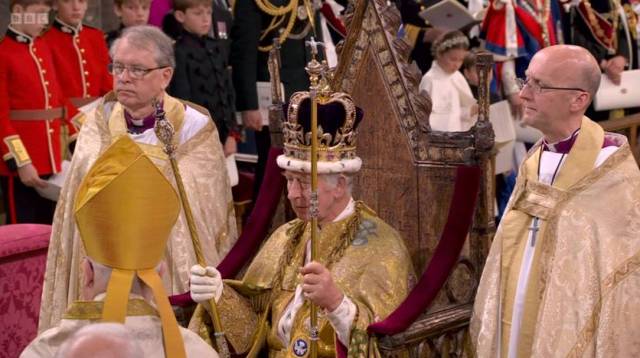
As I left home early in the morning on Coronation Day, 6 May, heading in the direction of Kensington Gardens and Hyde Park, there was that same stillness I’d witnessed on the morning of Her Majesty The Queen’s funeral in London last September. Yet the atmosphere was different, a sense of anticipation, which even the drizzling rain was not going to dampen. When I got closer to the park, where crowd control men and women in their fluorescent yellow jackets were manning the pathways, the early morning joggers were much in evidence. Cyclists – like me – were also wending their ways in different directions; but there were also groups of people walking purposefully, carrying Union Jack flags ready to wave, one person with a face-painted flag already in place, others wrapped in larger flags which they would no doubt later unfurl. All, I assumed, were carrying picnics for what was going to be a long day.
Once I entered the park I saw the same big television screens, which had been so prominently in place for people to watch the Queen’s funeral, but this time the mood among the crowds assembling was jovial. Despite the weather people were out to enjoy themselves; one woman who I engaged in conversation had supplemented her picnic with a bottle of brandy and some ginger to ward off the potential cold. And already the sound of the television broadcast could be heard loud and clear, ‘Land of Hope and Glory’ reverberating across the Serpentine. Closer to Westminster Abbey and Buckingham Palace I knew that thousands were lining the streets, many of whom had expectantly spent the night on the Mall, where the stately procession would pass, in order to witness what for all of us is a historic occasion: the Queen’s long life meaning that her son, who became heir to the throne aged three, would be making history by being the oldest monarch to be crowned King aged seventy-four.
The British monarchy and the modern Commonwealth
From the archives – Coronation and Commonwealth, III: Retrospect and Prospect
In front of a vast array of dignitaries, including all our surviving prime ministers and their spouses, who filled Westminster Abbey, the ritualistic ceremony – of anointing and investiture – began; once more we saw the Crown, Sceptre and Orb, which we’d last observed on top of the late Queen’s coffin, and which were to be an integral feature; so too the Gold Spurs, the Gold Bracelets, and the Ring, with which the King was to be invested. In demonstration of the monarchy’s continuity, the King was seated on the wooden throne of Edward I, commissioned in 1296 – which only twice in its existence has left Westminster Abbey, once in the 17th century during the protectorate of Oliver Cromwell and secondly, during World War II, for safekeeping. Beneath the seat was the Stone of Destiny on loan from the Commissioners for the Keeping of the Regalia in Scotland. Said to be the Prophet Jacob’s pillow, also known as the Stone of Scone, it too had a symbolic presence in the ceremony: an oblong block of red sandstone, on which the kings of Scotland were crowned, it had been taken by Edward I in 1296 and returned to Scotland seven hundred years later.
As with the Queen’s coronation in 1953, due recognition at King Charles’s coronation was given to the members of the Commonwealth with the flags of the member countries alternately lining the Mall alongside the Union Jack; each Commonwealth country’s flag was also brought into the Abbey as the respective representative took his or her seat. Like the late Queen’s Coronation dress, which had symbols of the Commonwealth embroidered into the fabric, the Canopy used for the anointing ceremony included symbols from Commonwealth countries. Only now instead of being a small grouping of several countries, the members of the Commonwealth number fifty-six, over one-third of which are African. Among these only fourteen have retained the King as Head of State.
What struck me most about the coronation ceremony, full of pageantry and exemplary precision, was the King’s attempt to involve all religious communities in what still is a very ancient Christian ceremony – a powerful reminder that in the present day, less than half of the population of the United Kingdom professes the Christian faith. Less progressive was the invitation for ‘a chorus of millions’ to swear allegiance to the King in a homage to the people, which seemed an unnecessary innovation since the King, like his mother, has already demonstrated a life of service and duty to the people.
The significance of the King’s coronation, together with that of the Queen, Camilla, was that, as Richard Hardman, royal correspondent, said, it was a very ‘21st Century Coronation’ – a first in so many ways, not just of the century, but of new traditions to which all the ‘working Royals’ are adapting – of inclusivity and multi-culturalism, an example so strikingly set by Queen Elizabeth II during her reign, but increasingly more relevant in the present day if the monarchy, as we know it, is to survive.
Victoria Schofield is Chair of The Round Table, the Commonwealth Journal of International Affairs



